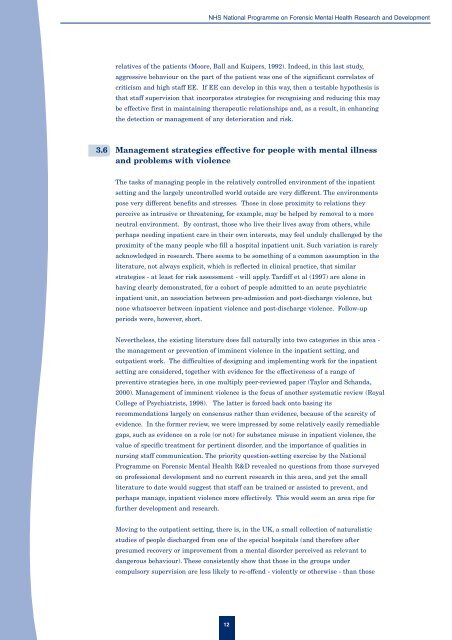Mental Illness and Serious Harm to Others - University of Liverpool
Mental Illness and Serious Harm to Others - University of Liverpool
Mental Illness and Serious Harm to Others - University of Liverpool
You also want an ePaper? Increase the reach of your titles
YUMPU automatically turns print PDFs into web optimized ePapers that Google loves.
NHS National Programme on Forensic <strong>Mental</strong> Health Research <strong>and</strong> Development<br />
relatives <strong>of</strong> the patients (Moore, Ball <strong>and</strong> Kuipers, 1992). Indeed, in this last study,<br />
aggressive behaviour on the part <strong>of</strong> the patient was one <strong>of</strong> the significant correlates <strong>of</strong><br />
criticism <strong>and</strong> high staff EE. If EE can develop in this way, then a testable hypothesis is<br />
that staff supervision that incorporates strategies for recognising <strong>and</strong> reducing this may<br />
be effective first in maintaining therapeutic relationships <strong>and</strong>, as a result, in enhancing<br />
the detection or management <strong>of</strong> any deterioration <strong>and</strong> risk.<br />
3.6 Management strategies effective for people with mental illness<br />
<strong>and</strong> problems with violence<br />
The tasks <strong>of</strong> managing people in the relatively controlled environment <strong>of</strong> the inpatient<br />
setting <strong>and</strong> the largely uncontrolled world outside are very different. The environments<br />
pose very different benefits <strong>and</strong> stresses. Those in close proximity <strong>to</strong> relations they<br />
perceive as intrusive or threatening, for example, may be helped by removal <strong>to</strong> a more<br />
neutral environment. By contrast, those who live their lives away from others, while<br />
perhaps needing inpatient care in their own interests, may feel unduly challenged by the<br />
proximity <strong>of</strong> the many people who fill a hospital inpatient unit. Such variation is rarely<br />
acknowledged in research. There seems <strong>to</strong> be something <strong>of</strong> a common assumption in the<br />
literature, not always explicit, which is reflected in clinical practice, that similar<br />
strategies - at least for risk assessment - will apply. Tardiff et al (1997) are alone in<br />
having clearly demonstrated, for a cohort <strong>of</strong> people admitted <strong>to</strong> an acute psychiatric<br />
inpatient unit, an association between pre-admission <strong>and</strong> post-discharge violence, but<br />
none whatsoever between inpatient violence <strong>and</strong> post-discharge violence. Follow-up<br />
periods were, however, short.<br />
Nevertheless, the existing literature does fall naturally in<strong>to</strong> two categories in this area -<br />
the management or prevention <strong>of</strong> imminent violence in the inpatient setting, <strong>and</strong><br />
outpatient work. The difficulties <strong>of</strong> designing <strong>and</strong> implementing work for the inpatient<br />
setting are considered, <strong>to</strong>gether with evidence for the effectiveness <strong>of</strong> a range <strong>of</strong><br />
preventive strategies here, in one multiply peer-reviewed paper (Taylor <strong>and</strong> Sch<strong>and</strong>a,<br />
2000). Management <strong>of</strong> imminent violence is the focus <strong>of</strong> another systematic review (Royal<br />
College <strong>of</strong> Psychiatrists, 1998). The latter is forced back on<strong>to</strong> basing its<br />
recommendations largely on consensus rather than evidence, because <strong>of</strong> the scarcity <strong>of</strong><br />
evidence. In the former review, we were impressed by some relatively easily remediable<br />
gaps, such as evidence on a role (or not) for substance misuse in inpatient violence, the<br />
value <strong>of</strong> specific treatment for pertinent disorder, <strong>and</strong> the importance <strong>of</strong> qualities in<br />
nursing staff communication. The priority question-setting exercise by the National<br />
Programme on Forensic <strong>Mental</strong> Health R&D revealed no questions from those surveyed<br />
on pr<strong>of</strong>essional development <strong>and</strong> no current research in this area, <strong>and</strong> yet the small<br />
literature <strong>to</strong> date would suggest that staff can be trained or assisted <strong>to</strong> prevent, <strong>and</strong><br />
perhaps manage, inpatient violence more effectively. This would seem an area ripe for<br />
further development <strong>and</strong> research.<br />
Moving <strong>to</strong> the outpatient setting, there is, in the UK, a small collection <strong>of</strong> naturalistic<br />
studies <strong>of</strong> people discharged from one <strong>of</strong> the special hospitals (<strong>and</strong> therefore after<br />
presumed recovery or improvement from a mental disorder perceived as relevant <strong>to</strong><br />
dangerous behaviour). These consistently show that those in the groups under<br />
compulsory supervision are less likely <strong>to</strong> re-<strong>of</strong>fend - violently or otherwise - than those<br />
12
















